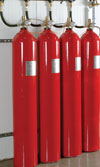

Saving money is in everyone’s best interest, particularly in a very competitive fire protection industry. The Fike ProInert Fire Extinguishing System design includes a distinct pressure regulating valve assembly different than standard inert gas systems on the market. This distinct design offers pipe and installation advantages resulting in overall system costs savings.
The Fike Inert Gas System is much more sophisticated than standard decaying pressure inert gas systems. The Fike system approach is to use a discharge valve that is designed to regulate the discharge pressure of the system to a constant 650 psi (44 bar) so the pipe pressure and nozzle flow rate(s) will be consistent for the duration of the discharge. Regulating the pressure at the valve outlet permits both low pressure rated piping to be installed in the entire system piping network. Smaller bore piping can also be used compared to standard inert gas systems. Both features present easier system installation and decreases the overall cost of the system installation.
According to a leading inert gas manufacturer, a systems peak flow rate occurs at 2 to 4 seconds into the discharge and is generally two to three times the average flow rate. As the pressure in the cylinder decays during the discharge, the orifice will continue to drop pressure in the same ratio, thus at approximately half the cylinder pressure the pipework pressure has dropped to 30 bar and the nozzle pressure to 10 bar. The use of orifice plates results in a very fast discharge rate initially and a very slow rate at the end of the discharge which at that point the extinguishing concentration is achieved.
NFPA and ISO standards require that 95% of the extinguishing concentration must be achieved within a 60-second time frame. This requirement is difficult to accomplish for orifice controlled inert gas systems without implementing other design measures. One method of achieving this regulatory requirement is to increase the quantity of stored extinguishant which increases the cost of the system and results in a higher concentration within the protected space which could potentially approach the NOEAL level of concentrations. Another industry known method to achieve this regulatory requirement is to implement a discharge time from 60 down to 45 seconds which results in higher discharge flow rates. Increasing a system flow rate results in a higher-pressure drop for a given size of pipe. To achieve a comparable pressure drop along the pipe the size needs to be larger in diameter.
For more information contact Mike Smiles, Masc Solutions, +27 (0)11 608 0065, [email protected]
| Tel: | +27 11 100 0088 |
| Email: | [email protected] |
| www: | www.mascsolutions.com |
| Articles: | More information and articles about Masc Solutions |

© Technews Publishing (Pty) Ltd. | All Rights Reserved.